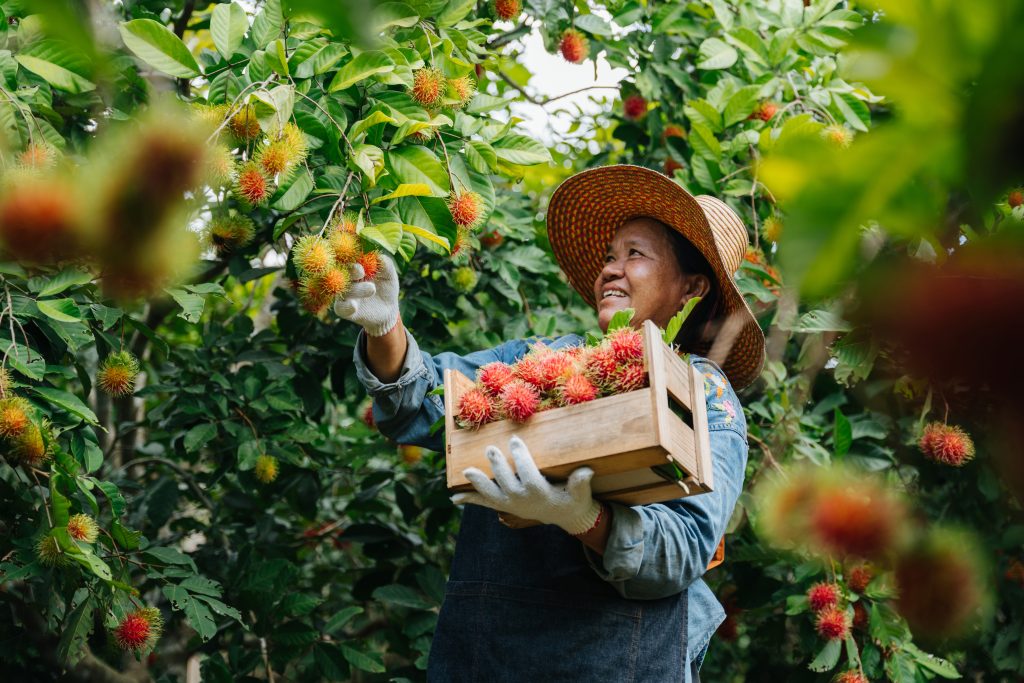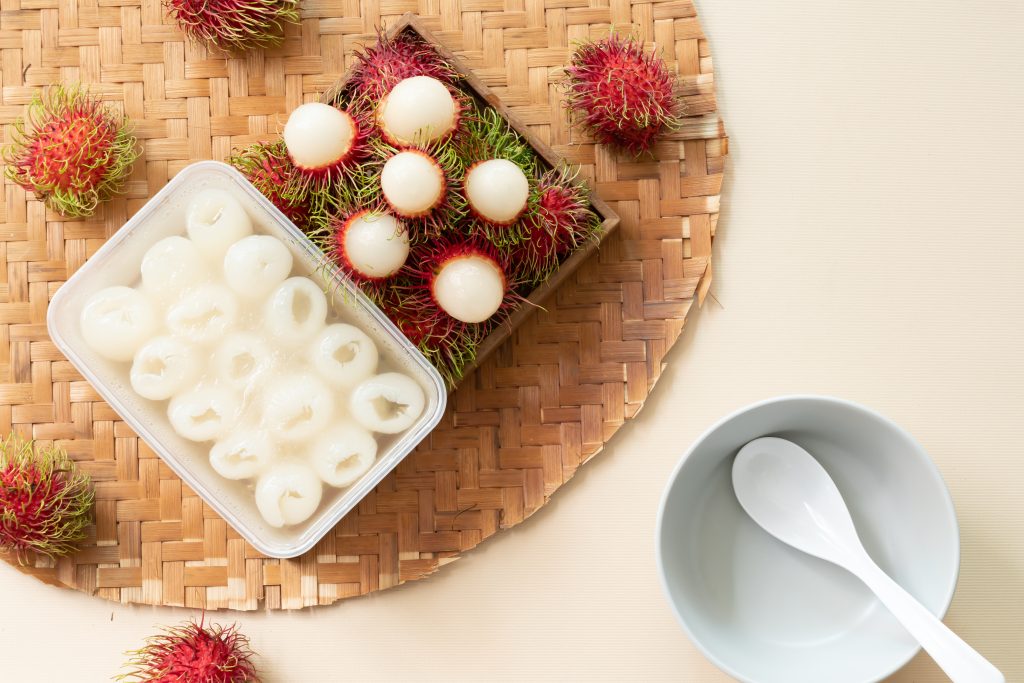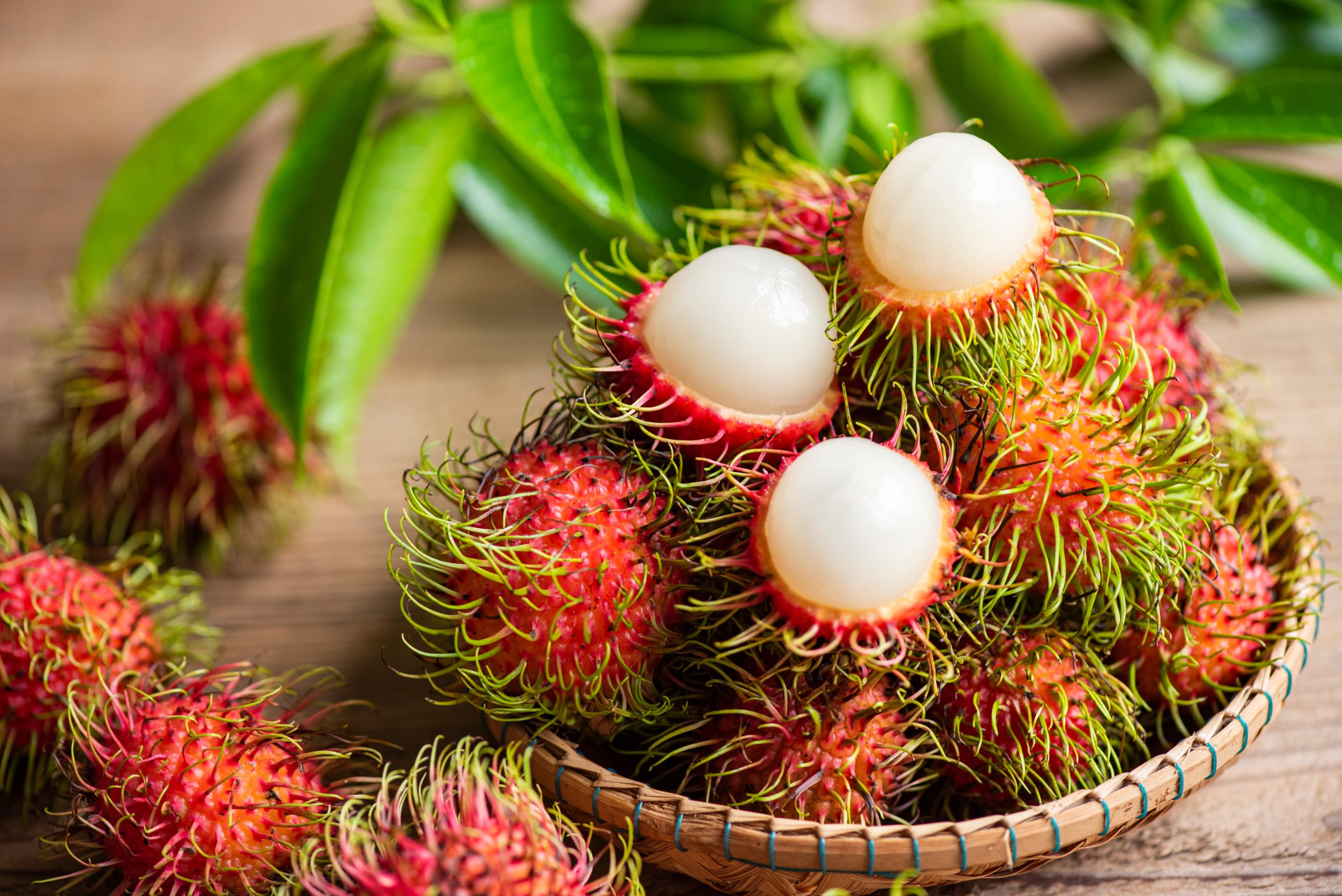Rambutan (Nephelium lappaceum) is a tropical fruit popular in Southeast Asia and Central America and is known for its distinctive hairy exterior and sweet, juicy white flesh. This fuzzy fruit is favored for its versatility as an ingredient in cooking, as well as for its many uses outside of the culinary realm.
Table of Contents
What is a Rambutan?
Rambutan (pronounced “rahm-boo-tahn”) is an exotic fruit that thrives in tropical climates and is native to Southeast Asia, specifically Malaysia, Indonesia, and the Philippines. It is also grown in other parts of the world, including Thailand, Vietnam, Sri Lanka, Hawaii, and some parts of Central and South America.
Rambutan is a member of the Sapindaceae family and is closely related to other tropical fruits such as lychee and longan. The fruit is roughly the size of a golf ball and covered in hairy, soft spines (or spinterns), typically green or red.
Rambutan comes from the Malay word “rambut,” which means “hair,” and highlights this fruit’s unique appearance that resembles a sea urchin. They’re also called chom chom in Vietnam, which translates to “messy hair.”
The skin is inedible and, when peeled away, reveals a translucent, juicy flesh surrounding a single seed that is also inedible unless adequately cooked. The flesh is typically white or pale pink and has a slightly acidic, sweet flavor similar to lychee fruit.
The History of Rambutan
The rambutan fruit is cultivated extensively across Southeast Asia and the archipelago. It was first brought to Zanzibar and Pemba by Arab traders many years ago.
It doesn’t currently grow in the United States, but the fruit’s popularity has risen in recent years due to its unique flavor and nutritional value.
Most rambutan is produced in Thailand, which started when a man named K. Vong cultivated it in Ban Na San for the first time back in 1926. To celebrate rambutan’s contribution to the agritourism industry, Thailand hosts an annual fruit fair that has it all: contests, parades, farm tours, contests, and beauty pageants!

What Does a Rambutan Taste Like?
Rambutan has flesh that is exquisitely juicy and chewy. The taste of rambutan can vary depending on the ripeness of the fruit, with riper fruit being sweeter and more flavorful. It is usually described as sweet and slightly sour with notes of strawberries and grapes.
Rambutan is typically eaten raw as a snack or as an ingredient in fruit salads and other dishes. It can also be cooked, although this is rare.
How to Tell When Rambutan is Ripe
The fruit should have a bright red – it can have some subtle orange or yellow tones when it’s ripe, but if you see some green coloring, it’s still not ready to eat. In contrast, if the rambutan has dark-colored skin or black hair, it’s overripe and not good to eat.
Ripe rambutan should have a sweet, fragrant aroma. If the fruit has no scent, it’s not ripe.
Are Rambutans and Lychee Related?
Both rambutan and lychee are part of the Sapindaceae (or soapberry) family, alongside longan fruit. But even if they are similar in taste, there are some notable differences between them.
Rambutans have a sweeter and milder taste than lychees, which have a more pronounced and slightly tart flavor. Lychees resemble watermelon or mangosteen in taste, while rambutan is as aromatic as dragon fruit.
Their appearance also differs. Rambutans have a red, spiky outer shell covered in soft, hair-like protrusions, while lychees have a rough, bumpy, and thin shell that is typically pink or red.
Can I Eat Raw Rambutan?
Most people actually prefer eating rambutan raw.
When cooked, rambutan can be used in sweet or savory dishes, and its flavor can become more concentrated and slightly caramelized. However, it is essential to note that cooking rambutan can also cause the flesh to become mushy and lose some of its texture and flavor, which is why it’s not a preferred method of eating it.
Cooking with Rambutan
Rambutan is mainly eaten as is or next to other fruits in a salad, but you can also sometimes cook it. Either way, here’s how you should always prep rambutan:
- Wash the rambutan fruit with water to remove any dirt or debris on its exterior.
- Use a sharp knife to cut the fruit in half around the equator. Avoid cutting too deeply into the seed in the middle.
- Use your fingers to open the rambutan and remove the seed in the middle. Be sure to discard the seed as it is not edible.
- Gently peel off the skin from the flesh using your fingers or a small knife.
Rambutan can be used in some sweet and savory dishes. In traditional Southeast Asian cuisines, you can use it in jams, jellies, curries, chutneys, ice cream, and other desserts. Some lovely dish ideas featuring rambutan include:
Rambutan Curry – a savory curry made with coconut milk, spices, and rambutan
Rambutan Chutney – a sweet and spicy condiment made with rambutan, ginger, chili peppers, and other aromatics
Rambutan Salad – a refreshing fruit salad made with rambutan, lychee, and other tropical fruits
Rambutan Sorbet – a refreshing and fruity frozen dessert made with pureed rambutan and sugar
Rambutan can also be used in baked goods like cakes, muffins, and tarts. Its sweet and tangy flavor pairs well with citrus fruits, coconut, and ginger.

How to Store Rambutan
Rambutan is a tropical fruit that is highly perishable and requires proper storage to extend its shelf life. Here are the best storage techniques for rambutan:
Room Temperature: Rambutan can be stored at room temperature for a day or two, especially if they need more ripening time. However, consuming the fruit as soon as possible is best since it can quickly deteriorate.
Refrigeration: Place the fruit in a perforated plastic bag or a container with a lid with some holes to allow air circulation. This way, rambutan can last for up to one week.
Freezing: You can freeze rambutan to extend its shelf life for up to six months. To do this, peel the fruit and remove the seed. Place the flesh in an airtight container or a freezer bag and store it in the freezer.
Nutritional Benefits of Rambutan
Rambutan has numerous health benefits. It is rich in vitamin C, helping the body absorb iron more efficiently, preventing cell damage, and boosting immune system function. It also contains a lot of fiber that helps with digestion.
Given that it is low in calories and high in soluble and insoluble fiber, it promotes weight loss by making you feel full for extended periods.
Rambutans are also a good source of calcium, carbohydrates, magnesium, manganese, potassium, and phosphorus.
The Other Uses of Rambutan
It’s a common misconception that rambutan is only used as a food, as it has many other uses.
Sunscreen
Rambutan has natural UV-blocking properties, making it a potential ingredient in sunscreen. In combination with synthetic organic sunscreens, it can increase their sun protection factor (SPF) values, and do so at a significantly lower cost.
Cosmetics
The fruit’s essential oil can help fight bacteria and fungi, making it useful for skin and hair problems. Rambutan can reduce skin inflammation, has anti-aging benefits, supports hair growth, and can help eradicate dandruff.
The fruit’s amino acids, flavonoids, and antioxidants can help build healthy skin cells, reduce wrinkles, and improve the skin’s firmness. Vitamin C and antioxidants in rambutan can strengthen hair roots and promote hair growth.
Biofuel
Studies show that some fruit waste could be reused in bioethanol production. More specifically, rambutan seeds contain oil that can be used as biofuel to replace engine diesel. This makes rambutan a potential source of renewable energy. However, more research is needed until this becomes a viable option.
Benefits to the Environment
Rambutan can enhance climate resilience. Rambutan trees can absorb carbon dioxide and release oxygen, which helps reduce the carbon footprint and prevents severe weather conditions like solid winds, erosion, and flooding. They are also known for enriching their surrounding soil, leading to more crops and higher productivity.
Where to Purchase Rambutan
You can find rambutan in the produce section of most grocery stores, but you’ll have even better chances of finding it at specialty Asian markets.
If you want to eat the world’s best rambutan, your best bet is to buy it from street vendors or supermarkets in Southeast Asia. Thailand and Indonesia are the perfect places to look for them.

